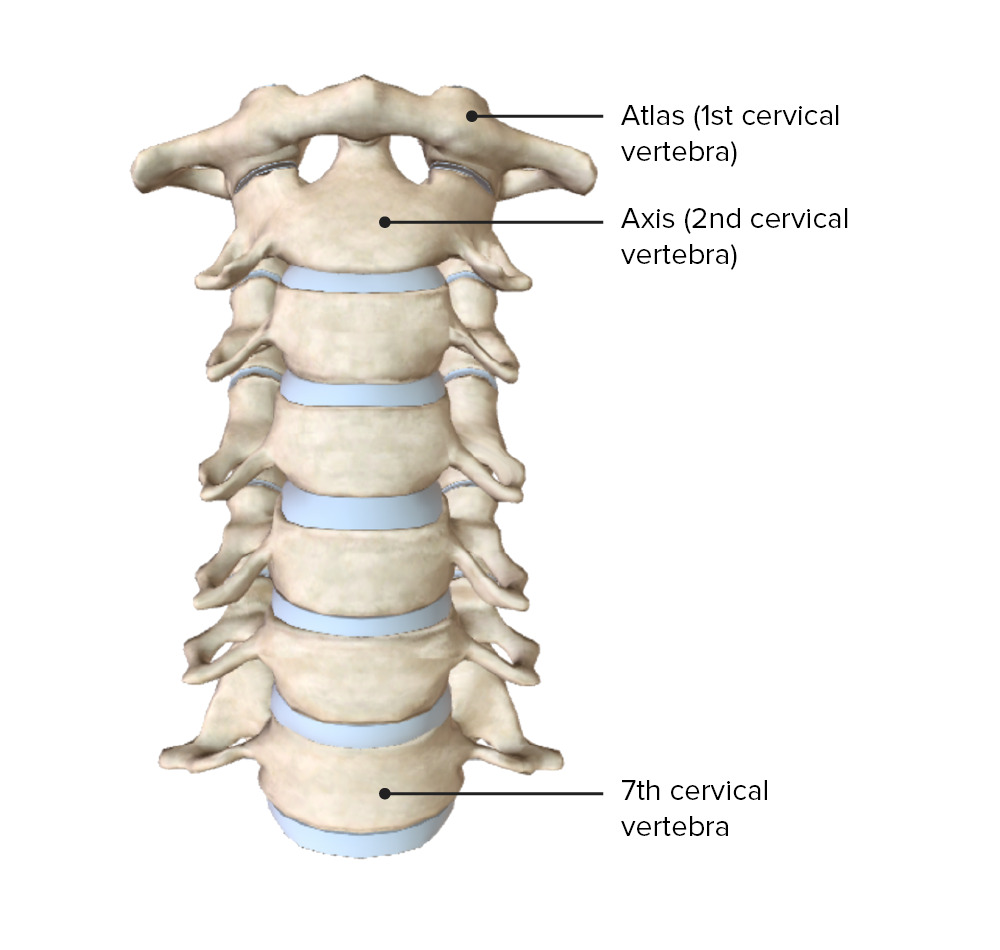Playlist
Show Playlist
Hide Playlist
Lumbar Spine: Introduction
-
Slides Osteopathic Diagnosis of the Lumbar Region.pdf
-
Download Lecture Overview
00:01 Osteopathic considerations of the lumbar spine. 00:03 So here, we wanna take a look at the lumbar spine which is really important and plays a lot of different factors to different pathologies that affect the body. 00:12 So the lumbar spine connects the thoracic and sacral region. 00:17 It consists of 5 vertebra and the vertebral bodies are a little bit taller anteriorly which contributes to the lordosis. 00:25 Kyphosis and scoliosis are other variations that could occur in the lumbar spine and the shape is affected by the different forces that affect the lumbar spine. 00:36 So there are many different forces that act on the spine. 00:38 There could be external forces such as gravity or any sort of trauma that could affect the lumbar spine. 00:46 Internally, we have intra-abdominal pressure. 00:49 We have different pulls from fascia and ligaments which causes a passive force or we could have active forces to our muscles and tendons and then the shape of the spine plays a role to our posture and could add to potential scoliosis curves. 01:04 There's axial compression so the lumbar spine bears the forces from above it acting on it. 01:12 Lumbar spine anatomy. 01:14 There are 5 vertebral bodies and they're separated by intervertebral disc. 01:18 The body's a little bit higher in the front like we said forming a lordosis. 01:22 They have large, thick, spinous processes. 01:25 They're usually fairly easy to find on palpation. 01:27 And the transverse processes, spinous processes and the bodies are all in the same level. 01:31 The superior facets are oriented in a way backwards and medial and this allows primarily for sagittal motion in flexion and extension. 01:41 The zygapophyseal joints where the superior and inferior facets articulate each other are synovial joints. 01:48 There are some variations that could occur in the lumbar spine. 01:51 You can have sacralization. 01:52 Usually this is a complete or partial fusion of the L5 vertebra to the sacrum. 01:57 And the opposite could occur, we have lumbarization. 02:00 So the sacral segments either S1 or S2 could be separate from the sacrum and act more like a lumbar segment. 02:08 The lumbar spine has many ligaments that connect between them. 02:11 We have the supraspinous ligaments that connects more on the tips of the spinous processes and that usually ends around L3. 02:19 You have your interspinous ligaments which connect between the spinous processes of the lumbar spine. 02:24 And you have the intertransverse ligaments which connects between the transverse processes, but at L4 and L5, they're replaced by iliolumbar ligaments cause it connects down to the ilium or the pelvis. 02:38 You have the anterior longitudinal ligament. 02:39 This is a very wide ligament on the anterior aspect of the lumbar spine and it prevents hyperextension. 02:47 Posteriorly, you have the posterior longitudinal ligament. 02:50 This ligament is a little bit more narrow. 02:52 It attaches to the disc and at the margins. 02:56 It helps to prevent hyperflexion. 02:58 It's narrow, so what happens is there's a little bit more of a weakness for potential herniation of the disc posteriorly. 03:05 The ligamentum flavum connects to the lamina, adjacent to the vertebrae and extends along the joint capsules to the spines. 03:14 There are several different pathologies in the lumbar spine and they all start with similar terms so I wanted to try to clarify them for you. 03:22 So there is spondylolysis and spondylolisthesis. 03:25 Spondylo- means spine -lysis means separation. 03:28 So, spondylolysis is a fracture of the pars in the spine. 03:32 Spondylolisthesis is anterior slippage. 03:36 So you can have a fracture which causes anterior slippage but when you have that anterior slippage, then it becomes spondylolisthesis. 03:43 Spondylolisthesis is really graded by the amount of slippage of the segments. 03:49 And so, if you have less that 25%, that's a grade I, less than 50% is grade II, and if it's up to a 100% anterior slippage then that's a grade IV. 04:02 There's another term called spondylosis. 04:04 Spondylosis is a general term given to gradual degeneration, kinda like wear and tear of the spinal disc and facets and this usually occurs with age Sometimes we refer that as spinal arthritis. 04:17 Sometimes it could be found via x-ray. 04:20 It doesn't necessarily have to be symptomatic. 04:24 Don't wanna confuse this with spondylolysis because spondylolysis means fracture. 04:29 Whereas, spondylosis just means degeneration.
About the Lecture
The lecture Lumbar Spine: Introduction by Sheldon C. Yao, DO is from the course Osteopathic Diagnosis of the Lumbar Region. It contains the following chapters:
- Introduction: Lumbar Spine
- Lumbar Spine – Ligamentous Anatomy
- Spondylolysis vs. Spondylolisthesis
Included Quiz Questions
When discussing the forces on the lumbar spine, which of the following is the major force acting on the lumbar spine?
- Axial compression
- Intra-abdominal pressure
- External load
- Muscle tension
- Ligament tension
Which of the following ligaments connects the tips of the spinous processes in the lumbar spine region?
- Supraspinous ligament
- Interspinous ligament
- Intertransverse ligament
- Iliolumbar ligament
- Anterior longitudinal ligament
Which of the following ligaments primarily prevents hyperextension of the lumbar spine?
- Anterior longitudinal ligament
- Supraspinous ligament
- Interspinous ligament
- Intertransverse ligament
- Iliolumbar ligament
Customer reviews
5,0 of 5 stars
| 5 Stars |
|
5 |
| 4 Stars |
|
0 |
| 3 Stars |
|
0 |
| 2 Stars |
|
0 |
| 1 Star |
|
0 |




